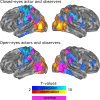Brain-to-brain hyperclassification reveals action-specific motor mapping of observed actions in humans
- PMID: 29228054
- PMCID: PMC5724834
- DOI: 10.1371/journal.pone.0189508
Brain-to-brain hyperclassification reveals action-specific motor mapping of observed actions in humans
Abstract
Seeing an action may activate the corresponding action motor code in the observer. It remains unresolved whether seeing and performing an action activates similar action-specific motor codes in the observer and the actor. We used novel hyperclassification approach to reveal shared brain activation signatures of action execution and observation in interacting human subjects. In the first experiment, two "actors" performed four types of hand actions while their haemodynamic brain activations were measured with 3-T functional magnetic resonance imaging (fMRI). The actions were videotaped and shown to 15 "observers" during a second fMRI experiment. Eleven observers saw the videos of one actor, and the remaining four observers saw the videos of the other actor. In a control fMRI experiment, one of the actors performed actions with closed eyes, and five new observers viewed these actions. Bayesian canonical correlation analysis was applied to functionally realign observers' and actors' fMRI data. Hyperclassification of the seen actions was performed with Bayesian logistic regression trained on actors' data and tested with observers' data. Without the functional realignment, between-subjects accuracy was at chance level. With the realignment, the accuracy increased on average by 15 percentage points, exceeding both the chance level and the accuracy without functional realignment. The highest accuracies were observed in occipital, parietal and premotor cortices. Hyperclassification exceeded chance level also when the actor did not see her own actions. We conclude that the functional brain activation signatures underlying action execution and observation are partly shared, yet these activation signatures may be anatomically misaligned across individuals.
Conflict of interest statement
Figures









References
-
- Gallese V, Fadiga L, Fogassi L, Rizzolatti G. Action recognition in the premotor cortex. 1996; Brain 119:593–609. - PubMed
-
- Rizzolatti G, Craighero L. The mirror-neuron system. 2004; Annu Rev Neurosci 27:169–192. doi: 10.1146/annurev.neuro.27.070203.144230 - DOI - PubMed
-
- Gazzola V, Keysers C. The observation and execution of actions share motor and somatosensory voxels in all tested subjects: single-subject analyses of unsmoothed fMRI data. 2009; Cereb Cortex 19:1239–1255. doi: 10.1093/cercor/bhn181 - DOI - PMC - PubMed
-
- Hari R, Kujala MV. Brain basis of human social interaction: from concepts to brain imaging. 2009; Physiol Rev 89:453–479. doi: 10.1152/physrev.00041.2007 - DOI - PubMed
Publication types
MeSH terms
Grants and funding
LinkOut - more resources
Full Text Sources
Other Literature Sources

